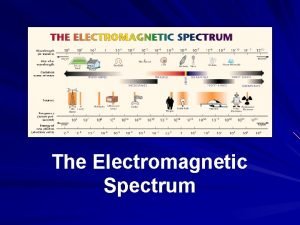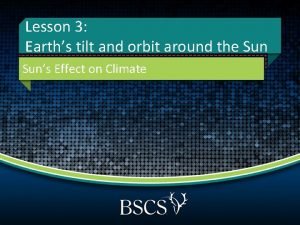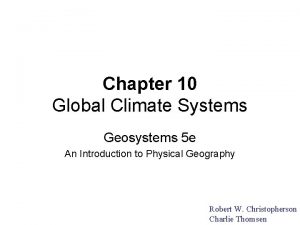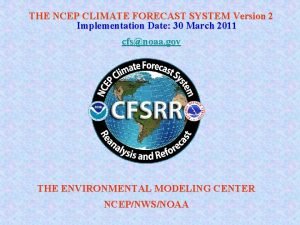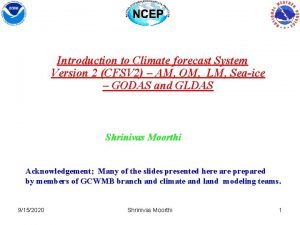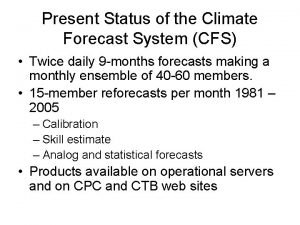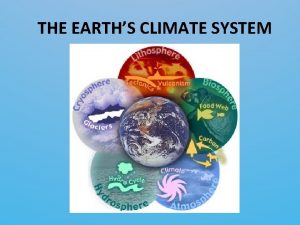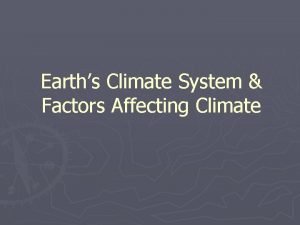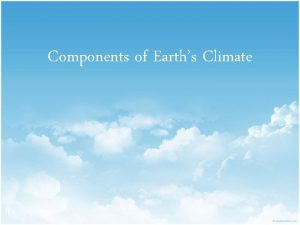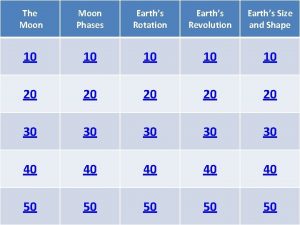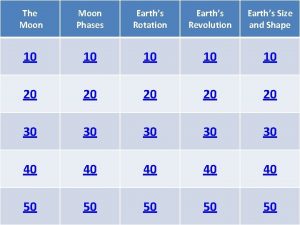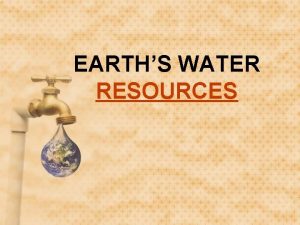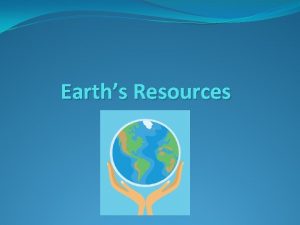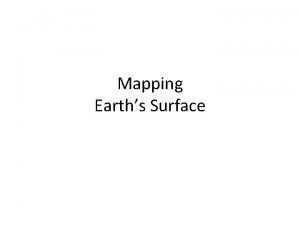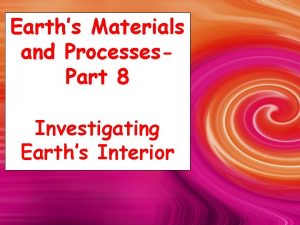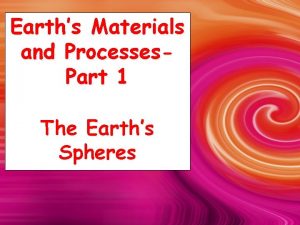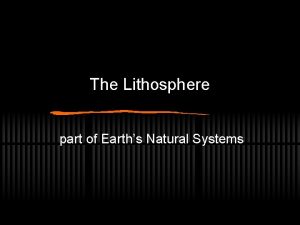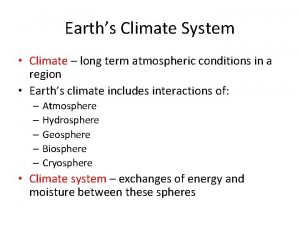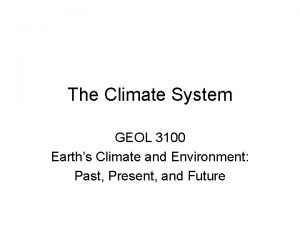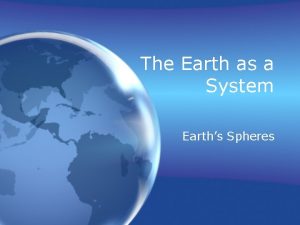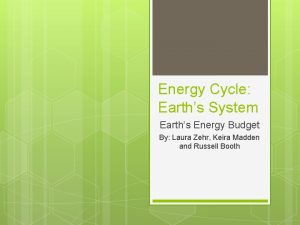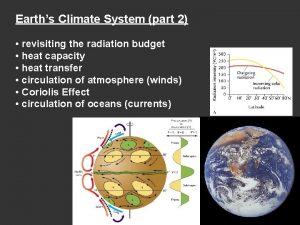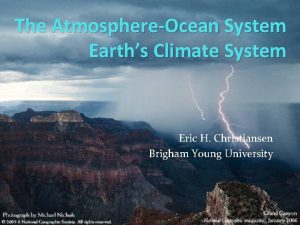Earths Climate System part 1 climate system electromagenetic









































- Slides: 41

Earth’s Climate System (part 1) • climate system • electromagenetic spectrum • Earth’s radiation budget • albedo • greenhouse effect

Earth’s climate system • climate driven by “solar energy” • climate operates to distribute solar energy across surface Can ask: Q 1. What is “solar energy”? Q 2. How does solar energy interact with planet?

What is solar energy? -- electromagnetic radiation (light) both a particle (photon) and wave photons can have different energies (wavelengths) high energies = shorter wavelengths low energies = longer wavelengths

Electromagnetic spectrum: describes what light of different wavelengths is called

How does solar energy interact with planet? -- some is stopped by atmosphere, some is not -- depends on wavelength atmosphere “transparent” for visible light, less so for other wavelengths

Consider the transparency of Earth’s atmosphere to light of (1) short wavelengths (2) medium wavelengths (3) long wavelengths

Short wavelengths a. k. a. “shortwave radiation” transparency in Earth’s atmosphere: very low (shortwaves almost completely blocked) UV & Ozone layer If not blocked, life as we know it wouldn’t exist on Earth -- cell damage!

Medium wavelengths a. k. a. “visible light” transparency in Earth’s atmosphere: mostly high (visible light mostly gets through, except when cloudy) If not transparent, life as we know it wouldn’t exist on Earth --too cold!

Long wavelengths a. k. a. “longwave radiation” transparency in Earth’s atmosphere: somewhat transparent (some longwaves get through, but not all) If not somewhat transparent, life as we know it wouldn’t exist on Earth -- too hot or cold! (Greenhouse Effect)

Radiation budget • describes inflow & outflow of solar energy • “budget” because energy is conserved energy in = energy used for warming + energy radiated back to space -- most of the “energy in” is visible light -- energy radiated towards space is visible light & IR light

Energy used for warming: -- absorbed by atmosphere -- absorbed by Earth’s surface ~70% of incoming Energy radiated back to space: -- reflected or scattered off of clouds or surface ~30% of incoming

Energy in

If sun overhead, get more photons concentrated in a smaller area. . . more energy in

Earth’s spin axis is inclined, so we get seasons

Energy out is controlled by albedo Albedo --the brightness of a surface can be quantified: 0% albedo --darkest surface --all light absorbed none reflected 100% albedo --brightest surface --all light reflected none absorbed


energy in = energy used for warming + energy radiated back to space % energy used for warming = (100 - albedo) % energy radiated back to space = albedo


High incident angle the amount of light absorbed depends on the incident angle of sunlight Albedo of water listed as 5 -10%… these diagrams imply not always true Low incident angle

Energy radiated back to space: -- reflected or scattered off of clouds or surface ~30% of incoming If ~30% of incoming solar energy is reflected back to space, what does this say about the overall average albedo of Earth?

~30% overall average

Can have temperaturealbedo feedback

warming Can we have temperaturealbedo feedback if the initial change is climate warming?

Can have temperaturevegetationalbedo feedback

Energy used for warming: -- absorbed by atmosphere -- absorbed by Earth’s surface ~70% of incoming Visible light that is absorbed does two things: (1) it raises the temperature directly (2) it is converted into lower energy (infrared) light

But recall that atmosphere is not completely transparent to IR light…. . . this means that the IR light can’t be radiated back to space easily. . . so it becomes trapped This leads to the Greenhouse Effect

Greenhouse Effect Visible light from the sun passes through the atmosphere and warms the surface. Heat radiated from the surface (infrared or IR light) travels back out into space but is absorbed or deflected back to the surface by certain gas molecules.

Greenhouse Effect. . . Trapped IR light warms the atmosphere, which warms the surface. Temperature goes up gradually.

Greenhouse effect.

Energy out

Main point of this is that ~95 -96% of the IR light radiated from the surface is trapped in the atmosphere --warming it & the Earth’s surface X Confusing!

Only some gases contribute to the Greenhouse Effect. • N 2 and O 2 (the main constituents of our atmosphere) are not greenhouse gases. • H 2 O, CFCs (chloroflourocarbons), CH 4, CO 2 are “greenhouse gases” and absorb IR light. • SO 2 is not a greenhouse gas. It combines with water to form H 2 SO 4 (sulfuric acid) droplets. These droplets reflect incoming solar light back into space, resulting in planetary cooling.

Greenhouse gases. • H 2 O is ubiquitous; we can’t control the amount of it in the atmosphere. • CH 4 is a fermentation product. Large amounts could be released from ocean (ice) deposits if the ocean warms. • CFCs are largely man-made. International agreements in the 1970 s limited their use, because of their harm to the ozone layer.

Greenhouse gases. • CO 2 is released by volcanoes. • CO 2 is produced by burning petroleum products and by burning trees. This can be controlled.

Is the greenhouse effect all bad? No! It makes life as we know it possible on Earth gets about 31 o C of greenhouse warming. Taverage = 15 o. C now, with Greenhouse Effect. Taverage = 15 - 31 o. C = -16 o. C, without Greenhouse Effect.

Climates on three planets Venus Earth Mars avg. temp. 460 o. C 15 o. C -55 o. C greenhouse warming 285 o. C 31 o. C 5 o. C avg. temp. with no 175 o. C -16 o. C -60 o. C greenhouse Just right Too cold

Climates on three planets Venus Earth Mars greenhouse warming 285 o. C 31 o. C 5 o. C atmosphere composition 96% CO 2 3. 5% N 2 OK with 77% N 2 21% O 2 0. 037% CO 2 0. 01% H 2 O 95% CO 2 2. 7% N 2

CO 2 abundance is rising in our atmosphere 10000 ppm = 1% so 370 ppm = 0. 037%

CH 4 abundance is also rising 1725 ppb = 1. 725 ppm = 0. 0001725%

Can have temperature. H 2 O vapor feedback possibly also with CO 2 and CH 4

 Em waves in order of increasing frequency
Em waves in order of increasing frequency Electromagenetic spectrum
Electromagenetic spectrum The earth's layers foldable
The earth's layers foldable Earths roation
Earths roation Whats earths moon called
Whats earths moon called Home sweet biome crossword
Home sweet biome crossword What are the families of the periodic table
What are the families of the periodic table Basalt
Basalt Whats earths moon called
Whats earths moon called What is earths thickest layer
What is earths thickest layer Earths early atmosphere contained
Earths early atmosphere contained The earth's layer foldable
The earth's layer foldable Earths major crustal plates
Earths major crustal plates Earths orbit seasons
Earths orbit seasons Brown earth soil ireland
Brown earth soil ireland Study of the earth's physical features
Study of the earth's physical features Honey as fertilizer
Honey as fertilizer Whats the name of earths moon
Whats the name of earths moon Continental drift theory notes
Continental drift theory notes Earths crust
Earths crust Where
Where What does the earths tilt cause
What does the earths tilt cause Earth's atmosphere description
Earth's atmosphere description What shape is the earths orbit
What shape is the earths orbit Arch of constantine frieze
Arch of constantine frieze What does earths tilt do
What does earths tilt do Earths boundaries
Earths boundaries 4 spheres of the earth
4 spheres of the earth Climate change 2014 mitigation of climate change
Climate change 2014 mitigation of climate change Addition symbol
Addition symbol Part to part ratio definition
Part to part ratio definition Brainpop ratios
Brainpop ratios Technical description meaning
Technical description meaning Name the parts of bar
Name the parts of bar The part of a shadow surrounding the darkest part
The part of a shadow surrounding the darkest part Minitab adalah
Minitab adalah Explain how köppen’s climate system classified climates.
Explain how köppen’s climate system classified climates. Climate forecast system version 2
Climate forecast system version 2 Climate forecast system version 2
Climate forecast system version 2 Reforecast past tense
Reforecast past tense Climate data management system
Climate data management system Respiratory system larynx
Respiratory system larynx
